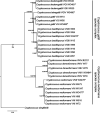Nanopore Sequencing of the Fungal Intergenic Spacer Sequence as a Potential Rapid Diagnostic Assay
- PMID: 32967904
- PMCID: PMC7685901
- DOI: 10.1128/JCM.01972-20
Nanopore Sequencing of the Fungal Intergenic Spacer Sequence as a Potential Rapid Diagnostic Assay
Abstract
Fungal infections are being caused by a broadening spectrum of fungi, yet in many cases, identification to the species level is required for proper antifungal selection. We investigated the fungal intergenic spacer (IGS) sequence in combination with nanopore sequencing for fungal identification. We sequenced isolates from two Cryptococcus species complexes, C. gattii and C. neoformans, which are the main pathogenic members of this genus, using the Oxford Nanopore Technologies MinION device and Sanger sequencing. There is enough variation within the two complexes to argue for further resolution into separate species, which we wanted to see if nanopore sequencing could detect. Using the R9.4.1 flow cell, IGS sequence identities averaged 99.57% compared to Sanger sequences of the same region. When the newer R10.3 flow cell was used, accuracy increased to 99.83% identity compared to the same Sanger sequences. Nanopore sequencing errors were predominantly in regions of homopolymers, with G homopolymers displaying the largest number of errors and C homopolymers displaying the least. Phylogenetic analysis of the nanopore- and Sanger-derived sequences resulted in indistinguishable trees. Comparison of average percent identities between the C. gattii and C. neoformans species complexes resulted in only a 74 to 77% identity between the two complexes. Sequencing using the nanopore platform could be completed in less than an hour, and samples could be multiplexed in groups as large as 24 sequences in a single run. These results suggest that sequencing the IGS region using nanopore sequencing could be a potential new molecular diagnostic strategy.
Keywords: DNA sequencing; diagnostic; fungal.
Copyright © 2020 American Society for Microbiology.
Figures


Similar articles
-
Comparative analysis of the intergenic spacer regions and population structure of the species complex of the pathogenic yeast Cryptococcus neoformans.FEMS Yeast Res. 2005 Dec;5(12):1129-40. doi: 10.1016/j.femsyr.2005.05.005. Epub 2005 Jul 1. FEMS Yeast Res. 2005. PMID: 16061425
-
Forensic nanopore sequencing of microhaplotype markers using QitanTech's QNome.Forensic Sci Int Genet. 2022 Mar;57:102657. doi: 10.1016/j.fsigen.2021.102657. Epub 2021 Dec 27. Forensic Sci Int Genet. 2022. PMID: 34973558
-
Comparison of Illumina versus Nanopore 16S rRNA Gene Sequencing of the Human Nasal Microbiota.Genes (Basel). 2020 Sep 21;11(9):1105. doi: 10.3390/genes11091105. Genes (Basel). 2020. PMID: 32967250 Free PMC article.
-
The Current State of Nanopore Sequencing.Methods Mol Biol. 2023;2632:3-14. doi: 10.1007/978-1-0716-2996-3_1. Methods Mol Biol. 2023. PMID: 36781717 Review.
-
[Nanopore Sequencing and its Application in Biology].Postepy Biochem. 2020 Aug 9;66(3):193-204. doi: 10.18388/pb.2020_328. Print 2020 Sep 30. Postepy Biochem. 2020. PMID: 33315321 Review. Polish.
Cited by
-
MinION Sequencing of Yeast Mock Communities To Assess the Effect of Databases and ITS-LSU Markers on the Reliability of Metabarcoding Analysis.Microbiol Spectr. 2023 Feb 14;11(1):e0105222. doi: 10.1128/spectrum.01052-22. Epub 2022 Dec 15. Microbiol Spectr. 2023. PMID: 36519933 Free PMC article.
-
Amplicon_sorter: A tool for reference-free amplicon sorting based on sequence similarity and for building consensus sequences.Ecol Evol. 2022 Mar 1;12(3):e8603. doi: 10.1002/ece3.8603. eCollection 2022 Feb. Ecol Evol. 2022. PMID: 35261737 Free PMC article.
-
A Barcoded ITS Primer-Based Nanopore Sequencing Protocol for Detection of Alternaria Species and Other Fungal Pathogens in Diverse Plant Hosts.J Fungi (Basel). 2025 Mar 25;11(4):249. doi: 10.3390/jof11040249. J Fungi (Basel). 2025. PMID: 40278070 Free PMC article.
-
Targeted sequencing analysis pipeline for species identification of human pathogenic fungi using long-read nanopore sequencing.IMA Fungus. 2023 Sep 6;14(1):18. doi: 10.1186/s43008-023-00125-6. IMA Fungus. 2023. PMID: 37674240 Free PMC article.
-
Nanopore-based metagenomic sequencing for the rapid and precise detection of pathogens among immunocompromised cancer patients with suspected infections.Front Cell Infect Microbiol. 2022 Sep 20;12:943859. doi: 10.3389/fcimb.2022.943859. eCollection 2022. Front Cell Infect Microbiol. 2022. PMID: 36204638 Free PMC article.
References
MeSH terms
Substances
Grants and funding
LinkOut - more resources
Full Text Sources

